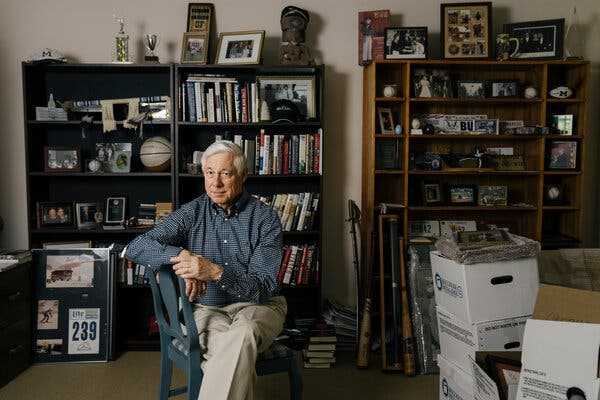Legal scholars say a long-forgotten provision of the Constitution could bar from office anyone who encouraged the Capitol riot.

An obscure 19th-century provision of the U.S. Constitution that barred members of the Confederacy from holding political office is back in the national conversation — and some are hoping it can keep Donald J. Trump and his allies off the ballot.
After the Civil War, Congress sought to remake the politics of the states they had just defeated on the battlefield. Fearing that the grandees of the Old South would slink back to power, they crafted Section 3 of the 14th Amendment, known as the Disqualification Clause.
The provision applied to anyone who had previously taken an oath to support the Constitution and then either “engaged in insurrection or rebellion” against the United States or gave “aid or comfort to the enemies thereof.”
The clause, tucked into an amendment better known for extending citizenship to African Americans, was largely an object of academic curiosity until last week. That’s when lawyers representing a group of North Carolina voters filed a novel legal challenge seeking to keep Representative Madison Cawthorn off the ballot this year.
Cawthorn is a close ally of Mark Meadows, Trump’s former chief of staff, and has made comments suggesting he supported the Jan. 6 riot at the Capitol. The complaint alleged that his actions trigger the Disqualification Clause, making him ineligible to serve in Congress.
Cawthorn has shrugged off the challenge.
“Over 245,000 patriots from Western North Carolina elected Congressman Cawthorn to serve them in Washington,” said Luke Ball, a spokesman for Cawthorn. “A dozen activists who are comically misinterpreting and twisting the 14th Amendment for political gain will not distract him from that service.”
For now, the challenge is on hold while redistricting litigation in the state plays out. But it’s likely to be just one of many similar actions to come.
“Madison Cawthorn was the first, but it’s safe to say he won’t be the last,” Ron Fein, a lawyer for Free Speech for People, the group behind the complaint, said in an interview.
An outside-in strategy
Win or lose, the Cawthorn case could help investigators in Washington by unlocking new evidence about the North Carolina lawmaker’s activities related to Jan. 6. He might have to sit for a deposition and have to turn over, say, his phone and email records.
As the litigation makes its way through the court system, it could also help clear up a few broader questions:
-
Was Jan. 6 an “insurrection,” legally speaking?
-
What does it mean to be “engaged” in insurrection, and what level of involvement triggers the Disqualification Clause?
-
Does Congress need to pass a law or resolution to activate it?
“Most people, me included, think it was an insurrection, but neither Congress nor the courts have made that official determination,” said Mark Graber, a legal historian at the University of Maryland.
Laurence Tribe, an influential law professor at Harvard University, has held private conversations with several members of Congress on the topic as they puzzle through how statutes written in the 1860s might apply in an entirely new context. And while Tribe’s view is that Jan. 6 was indeed an insurrection, it is by no means obvious how courts will interpret the 14th Amendment without clearer signals from Congress.
“You’re dealing with a very murky and open area of constitutional law,” Tribe said in an interview.
Even one of the foremost experts on the Disqualification Clause, Gerard Magliocca of Indiana University, called it “vestigial” in a well-timed paper on the subject published in 2020 three weeks before Jan. 6. He has since become an advocate for applying it to disqualify Trump from running for president in 2024.
“We have to dust it off,” said Representative Jamie Raskin, a Democrat of Maryland who has consulted with Tribe on the topic. “It hasn’t been used in more than a century.”
In fact, it’s been used precisely once since the Reconstruction era — in the 1919 case of Victor L. Berger, a socialist from Wisconsin who was removed from Congress after being accused of harboring pro-German sympathies. Berger was later reinstated when the Supreme Court tossed out his conviction for espionage, on the grounds that the judge harbored an anti-German bias.
Fox News weighs in
For now, the Disqualification Clause is getting more attention on Fox News than it is within Congress — driven almost entirely by a single tweet from Marc Elias, the Democratic Party’s top election lawyer, who had predicted the provision might soon arise in litigation.
Tucker Carlson, the Fox News opinion host, held a nearly four-minute segment on Elias’s 38-word post.
“So, if you don’t want to lose the Congress, just ban the other side from running,” Carlson said sarcastically, going on to compare the idea that Jan. 6 was an insurrection to a belief in U.F.O.s.
“This would require establishing that such individuals supported an actual insurrection,” Laura Ingraham, Carlson’s Fox News colleague, said of the Elias tweet a day later. “Good luck with that.”
Inside the committee investigating the Jan. 6 riot, however, the Disqualification Clause has not come up in any detail.
Some Democratic lawmakers — including Raskin, Senator Tim Kaine of Virginia and a few others — did float the idea a year ago. At the time, they were searching for a way to hold Trump accountable that would require only a simple majority vote in the Senate.
But when Democratic legal experts investigated the concept, they determined that the Disqualification Clause was not “self-executing” — that is, Congress would need to pass a law or resolution to use it and clarify how it applies today. One can’t just declare someone an insurrectionist, they decided; Congress has to create the legal infrastructure to try someone and give them due process before taking away their right to hold public office. That made it less attractive as an alternative to impeachment.
Depending on what the Jan. 6 panel uncovers, it’s possible to imagine the committee will recommend punishing lawmakers who were somehow involved in the riot. It’s also possible Democrats will decide to take their case to voters instead.
Key Figures in the Jan. 6 Inquiry
Card 1 of 16
The House investigation. A select committee is scrutinizing the causes of the Jan. 6 riot at the U.S. Capitol, which occurred as Congress met to formalize Joe Biden’s election victory amid various efforts to overturn the results. Here are some key figures in the inquiry:
Donald Trump. The former president’s movement and communications on Jan. 6 appear to be a focus of the inquiry. While Mr. Trump has invoked executive privilege in an attempt to shield his records, the Supreme Court refused to block the release of the files.
Kevin McCarthy. The panel has requested an interview with the House Republican leader about his contact with Mr. Trump during the riot. The California representative, who could become speaker of the House after the midterms in November, has refused to cooperate.
Rudolph Giuliani. The panel has subpoenaed Mr. Trump’s personal lawyer and three members of the legal team — Jenna Ellis, Sidney Powell and Boris Epshteyn — who pursued conspiracy-filled lawsuits that made claims of voter fraud in the 2020 election.
Mike Pence. The former vice president could be a key witness as the committee focuses on Mr. Trump’s responsibility for the riot and considers criminal referrals, but Mr. Pence reportedly has not decided whether to cooperate.
Mark Meadows. Mr. Trump’s chief of staff, who initially provided the panel with a trove of documents that showed the extent of his role in the efforts to overturn the election, is now refusing to cooperate. The House voted to recommend holding Mr. Meadows in criminal contempt of Congress.
Scott Perry and Jim Jordan. The Republican representatives of Pennsylvania and Ohio are among a group of G.O.P. congressmen who were deeply involved in efforts to overturn the election. Both Mr. Perry and Mr. Jordan have refused to cooperate with the panel.
Fox News anchors. Texts between Sean Hannity and Trump officials in the days surrounding the riot illustrate the host’s unusually elevated role as an outside adviser. Mr. Hannity, along with Laura Ingraham and Brian Kilmeade, also texted Mr. Meadows as the riot unfolded.
Big Tech firms. The panel has criticized Alphabet, Meta, Reddit and Twitter for allowing extremism to spread on their platforms and saying they have failed to cooperate adequately with the inquiry. The committee has issued subpoenas to all four companies.
Far-right figures. White nationalist leaders and militia groups are being scrutinized as the panel’s focus intensifies on the rallies that led up to the mob violence and how those with extremist views worked with pro-Trump forces to undermine the election.
Roger Stone and Alex Jones. The panel’s interest in the political operative and the conspiracy theorist indicate that investigators are intent on learning the details of the planning and financing of rallies that drew Mr. Trump’s supporters to Washington based on his lies of a stolen election.
Steve Bannon. The former Trump aide has been charged with contempt of Congress for refusing to comply with a subpoena, claiming protection under executive privilege even though he was an outside adviser. His trial is scheduled for next summer.
Michael Flynn. Mr. Trump’s former national security adviser attended an Oval Office meeting on Dec. 18 in which participants discussed seizing voting machines and invoking certain national security emergency powers. Mr. Flynn has filed a lawsuit to block the panel’s subpoenas.
Phil Waldron. The retired Army colonel has been under scrutiny since a 38-page PowerPoint document he circulated on Capitol Hill was turned over to the panel by Mr. Meadows. The document contained extreme plans to overturn the election.
Jeffrey Clark. The little-known Justice Department official repeatedly pushed his colleagues to help Mr. Trump undo his loss. The panel has recommended that Mr. Clark be held in criminal contempt of Congress for refusing to cooperate.
John Eastman. The lawyer has been the subject of intense scrutiny since writing a memo that laid out how Mr. Trump could stay in power. Mr. Eastman was present at a meeting of Trump allies at the Willard Hotel that has become a prime focus of the panel.
Courts might dodge the question altogether, noting that Congress has better-established tools for policing its membership. By a simple majority, the House and the Senate can refuse to seat a newly elected lawmaker. Or, each chamber can eject one of its own by a two-thirds vote.
“I’m skeptical that a court would be willing to jump into the breach if Congress isn’t willing to expel a member itself and has not provided any explicit statutory scheme for doing so,” said Keith Whittington, a professor of politics at Princeton University.
What about Trump?
Lowly House lawmakers are one thing; a former president of the United States is quite another. If Trump were to run again in 2024, some on the left would certainly try to disqualify him, leading to pitched legal battles across the country.
“It could be a state court, it could be a federal court,” Tribe said. “It would depend on who takes the first step in this chess match. I could map out dozens of litigation paths, all of which would end up in the United States Supreme Court.”
Already, the nonprofit behind the Cawthorn challenge is partnering with Our Revolution, an advocacy group aligned with Senator Bernie Sanders of Vermont, on a project called The 14Point3 Campaign. The two organizations are asking their followers to send letters to secretaries of state across the country, demanding they “exclude Mr. Trump from the ballot” because of the Disqualification Clause.
Some argue it might be politically unwise for the Democratic Party to back such efforts.
“If Trump can recast himself as the defender of the majority’s right to choose its leader, that would be a disaster,” said Daniel Hemel, a law professor at the University of Chicago who wrote a guide last year to using the Disqualification Clause but has since grown leery of the idea. “If we try to stop him and fail — and it will likely fail — then we’ve just added to the Trump mythology.”
Image
What to read
-
In a fiery news conference, President Biden said he expected President Vladimir Putin of Russia to invade Ukraine. “But I think he will pay a serious and dear price for it,” Biden said. “And I think he will regret having done it.”
-
Carl Hulse and Jonathan Weisman chronicle the growing frustration among Democrats with two members of their own party, Senators Kyrsten Sinema and Joe Manchin III, over their opposition to altering filibuster rules to pass two federal voting-rights bills pushed by the White House.
-
In an unusual effort to push back against reports of internal rancor, three Supreme Court justices issued statements denying they had sparred over face masks, Adam Liptak reports.
ImageImageSenator Jon Tester offered a novel explanation for Senate dysfunction: laziness.Credit…Stefani Reynolds for The New York Times
One more thing…
Amid a floor debate on Wednesday over whether to bring back the talking filibuster, Senator Jon Tester, Democrat of Montana, blasted the Senate as “incredibly dysfunctional.”
And he offered a surprising theory as to why.
“I think what’s gone wrong is we’ve gotten lazy,” Tester explained. “I mean the last place, truthfully, the last place I want to be is on the floor of the United States Senate trying to justify my position. I mean, that’s a lot of work. It takes time. It takes effort. We ought to be forcing people to do that.”
A filibuster — when a minority of lawmakers seek to delay or block the Senate from voting, usually by talking nonstop for hours — is indeed a lot of work. As far as we know, the longest filibuster in American history was by Bill Meier, a Texas state legislator who spoke for 43 hours back in 1977. An account by our colleague Manny Fernandez explained how he did it:
“He read verbatim from more than 200 legal cases from dozens of law books lined up on the floor. He sucked on hard candy, ate a few lemon slices and sipped water. And he wore an ‘astronaut bag’ attached to his leg under his pants — like a hot water bottle — so he could answer nature’s call without interruption.”
Image
Is there anything you think we’re missing? Anything you want to see more of? We’d love to hear from you. Email us at [email protected].
Source: nytimes.com



